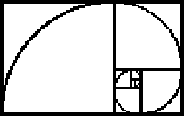1 + 1 = 2
1 + 2 = 3
2 + 3 = 5
3 + 5 = 8
5 + 8 = 13 etc.

THE GOLDEN MEAN
The Golden Mean, 1.61803398874989…, represented by the Greek letter phi, is a naturally occurring number, like pi, that repeatedly occurs in various relationships. Like pi, it is an irrational number. Unlike pi, it clearly and regularly appears in the growth patterns of many living things, like the spiral formed by a seashell or the curve of a fern. It is in fact the only growth pattern that, if continued, is not doomed to failure. It was derived by the ancient Greeks and was used by them and the ancient Egyptians in the design of their buildings and monuments. They had discovered they could create a feeling of natural order, as well as structural integrity, in their works. Artists since have used it for the same reason, to create a feeling of natural order in their works. It is thought by many people to describe the most aesthetically pleasing rectangle.
Leonard of Pisa (1170-1250), better known as Fibonacci, introduced the Fibonacci Series, a sequence of numbers; 0, 1, 1, 2, 3, 5, 8, 13, 21, 34, … in which any number is the sum of the two preceding members.
|
0 + 1 = 1 1 + 1 = 2 1 + 2 = 3 2 + 3 = 5 3 + 5 = 8 5 + 8 = 13 etc. |
 |
The Fibonacci Series and the Golden Mean are intimately connected. The Fibonacci Series numbers increase at a rate equal to (actually, oscillating round) the Golden mean. (The larger the numbers, the closer to the Golden Mean.)
A rectangle whose sides are related by phi (such as 13 x 8) is said to be a Golden Rectangle. It has the interesting property that, if you create a new rectangle by swinging the long side around one of its ends outward from the rectangle, to create a new long side, (in combination with the short side), then that new rectangle is also a golden rectangle. In the case of our 13 x 8 rectangle, the new rectangle will be 21 x 13. We see that this is the same thing that's going on in the Fibonacci Series.
Starting with a Golden Rectangle whose short side equals one, and swinging the long side around forms a line (in combination with the short side) made up of two sections having lengths of phi and one, respectively. This division of a straight line into a phi proportion is what is actually meant by the term Golden Section.
Proportion is the relationship of the size of two things. Arithmetic proportion exists when a quantity is changed by adding some amount. Geometric proportion exists when a quantity is changed by multiplying by some amount. Phi possesses both qualities, and as such, is considered perfect proportion, also referred to as the Divine Proportion.
From the Fibonacci Series and the Golden Rectangle we realize
that: phi + 1 = phi x phi. If we start with a Golden rectangle
having a short side one unit long, then the long side equals the
short side multiplied by phi, or phi. If we swing the long side
to make a new Golden rectangle, The short side of the new rectangle
is phi, and the long side is that side times phi, or phi x
phi. This is a Geometric proportion. We also know from simple
arithmetic that the new long side equals the sum of the two sides
of the original rectangle, or phi + 1. This is an Arithmetic
proportion. Since these two expressions describe the same thing:
phi + 1 = phi x phi. From this relationship, we can calculate
the value of phi. Thus we see that the Golden Mean proportion
is both arithmetic and geometric. Graphically it is the
place(s) where the curved line of multiplication crosses the straight
line of addition.